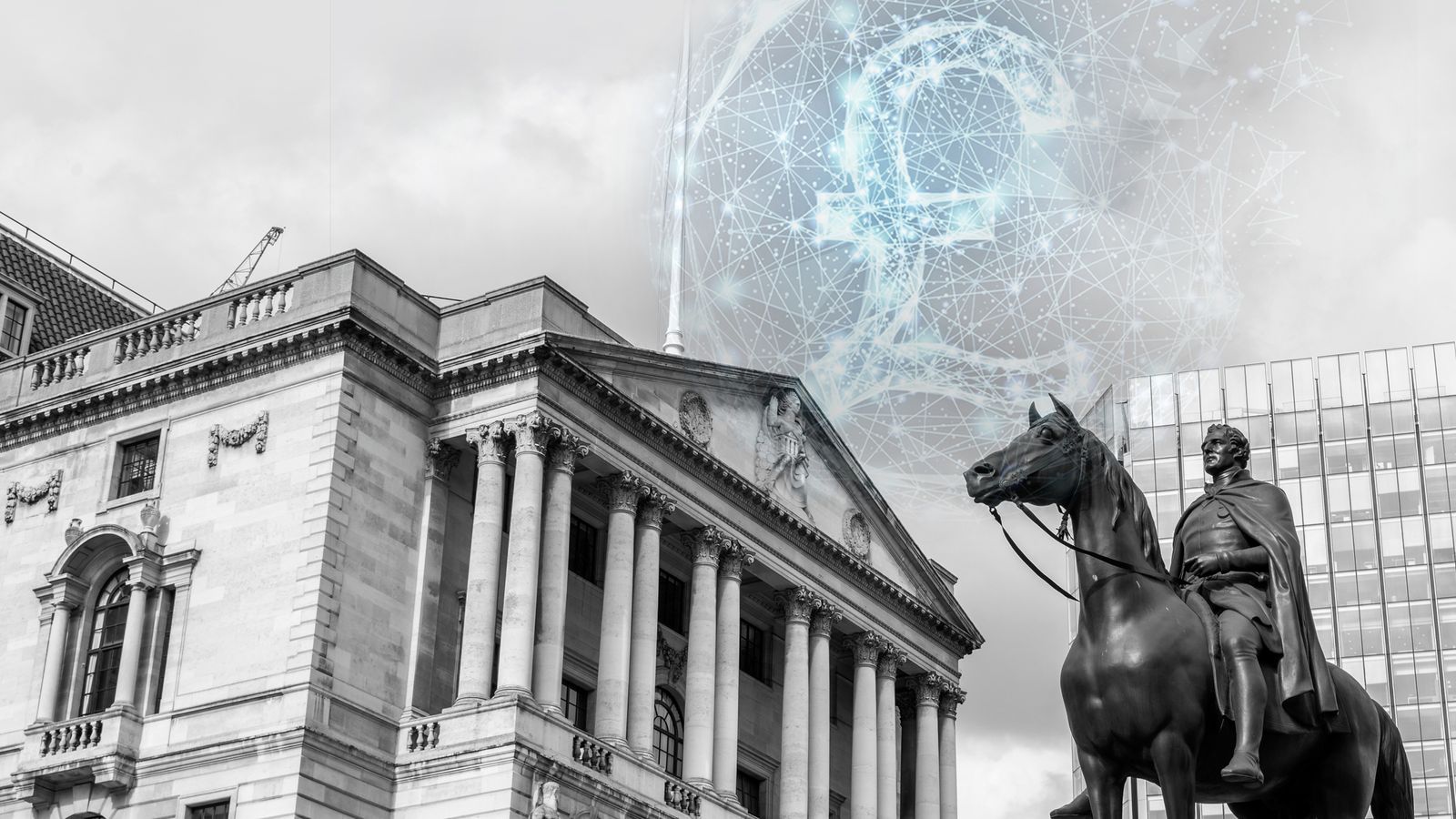It is hard, on the face of it, to know whether to be excited or underwhelmed by the news today that the Bank of England is launching a “taskforce” on creating its own digital currency.
You could be excused for concluding they could hardly be moving any more slowly.
Here we are, living in an age when Bitcoin, Ethereum and other privately-issued digital currencies are already establishing themselves as multibillion dollar markets.
Coinbase, a kind of exchange for crypto, listed on Nasdaq last week with a valuation that makes it, on paper at least, worth around double the London Stock Exchange.
Now consider the central bank response.
The Bank of England has been thinking out loud about digital currencies for a long time, for instance in a discussion paper last year and in any number of speeches. But thinking is one thing and doing is quite another, and there are still no plans, according to today’s announcement, to introduce a digital central bank currency (DCBC).
On the other side of the Channel, the European Central Bank is in a more or less similar holding pattern, albeit slightly more advanced. It’s still in the “exploratory talks” phase but is expected to announce whether it will launch its ECBC this year.
The Federal Reserve, meanwhile, seems even less enthusiastic than its European counterparts, for the time being at least.
Now contrast this with what is happening in China, where the People’s Bank is already far advanced with its pilot of a digital Renminbi.
To some extent, this is only to be expected. China already leads the world in electronic payments. Anyone who’s spent a bit of time there will know the extent to which it’s becoming nearly impossible to buy anything without using your smartphone.
It is perhaps understandable that Beijing is now seeking to impose some control over this activity.
Then again, look at the extent to which cashless payments are being used in various countries, as a percentage of GDP, and actually it’s the UK that leads the world – with even more transactions as a percentage of GDP than China.
Now, in practice here in Britain “cashless” mostly means credit and debit card transactions whereas in China it mostly means smartphone and other technology-based transactions. In one sense these are quite different things. But from the perspective of a central bank there are some similarities.
To see what I mean it helps to go back to first principles. In this and most countries the most “reliable” form of money is the money issued by the central bank (clearly this doesn’t go for some developing countries with histories of default and hyperinflation).
We could have a long conversation in this case about what “reliable” means, but in this case let’s take it to mean money that you and the person you’re transacting with will know is likely to be accepted by anyone else they then want to transact or bank with.
The only form of central bank money you and I can use are physical banknotes. When we transact in the other ways we mostly do these days – so via our cards or direct debits or electronic money or pretty much anything save for cryptocurrencies – we are typically using commercial bank money.
This is money “created” by commercial banks. Those commercial banks use central bank reserves to settle their accounts with each other at the end of the day.
Britcoin? #UKFW21 https://t.co/Slk5lwUvrV
Let’s say you buy something at a shop. If you use cash the process is pretty straightforward: you had the money, now they have the money. If you use a debit card then the money goes from your account into theirs (minus a transaction fee which goes to Visa or another such company) in the form of commercial bank money.
At the end of the day your bank looks through its accounts and, theoretically at least, sends some central bank reserves to the main account of the shop’s bank (or, if you both bank with the same banking group, they don’t need to do anything).
Now, this is a massively oversimplified example (and no doubt I’ve committed some technical howlers banking purists will be screaming at) but it underlines a crucial point: there is already such a thing as central bank digital money. But not a kind that you or I can use: it’s just used by banks to settle their accounts with each other.
This model is in many ways the foundation of modern finance. The central bank sits atop a financial system, which in turn sits atop customer accounts.
When the Bank of England changes interest rates what it’s really doing is changing the rate it charges and pays on reserves, with the expectation that those changes are in turn passed on to customers. You get the idea: you and I can’t have a bank account at the Bank of England, but these commercial banks do.
But what if you or I could have an account at the central bank? Or failing that, what if we could specify that we wanted the money in our accounts to be backed by the central bank rather than HSBC or RBS or whoever?
It’s quite likely this kind of money would be incredibly popular; after all, you’d no longer have to worry about whether your bank might be about to go bust and you’d only have to worry about the extent to which your country was going to go bust, or inflate away the currency.
And that, in a sense, is the point behind central bank digital currencies: that you and I would suddenly have access to that digital money that up until now only private banks have been able to access.
At this stage you’re probably cottoning on that this isn’t really just a story about Bitcoin and other cryptocurrencies but about the nature of money and, more immediately, about banking systems. Or to put it another way, the institution most under threat from CBDC might not be cryptocurrencies but the banking and financial system itself.
Perhaps this is why the Bank of England is at pains to emphasise in most of the material it’s been producing around digital currencies that this “would be introduced alongside – rather than replacing – cash and bank deposits”.
Even so, in its discussion paper, the bank points out one area where it looks to some extent like CBDC could disrupt some of the work done by commercial banks:
“One of the most interesting features that has emerged through developments in DLT is the potential to create ‘programmable money’. This can be implemented via the use of ‘smart contracts’ – pieces of code which are able to self‐execute payments based on some pre‐defined criteria. In simple terms, these contracts are statements that say ‘If X happens, then pay Y to Z’.
“An example would be a forward‐dated payment: ‘If today’s date is X, then transfer £100 from account Y to account Z’. More advanced smart contracts could be used (for example) to automatically initiate payments on the confirmed receipt of goods, or routing tax payments directly to the tax authorities at point of sale. Transactions could also be integrated with physical devices, or the ‘Internet of Things’, for example code could be written to say ‘when £X is transferred to account Y, switch on device Z’.”
Nor is this the only intriguing possibility raised by CBDCs. Remember one of the big debates in UK monetary policy right now is whether it might be practicable for the Bank to cut interest rates below zero. There’s a pragmatic reason for this: many banks, and especially building societies, have business models which are quite reliant on rates being above zero.
Now consider: if you have an account denominated in UK central bank money, it would have interest paid at precisely the Bank of England interest rate, but it could also plausibly impose negative interest rates without causing the kinds of financial ripples which might happen if it relied on the existing financial system.
You get the idea: this could have enormous consequences on the transmission mechanism of monetary policy, which up until now has involved a chain reaction that wasn’t always entirely predictable.
Or here’s another prospect, raised recently by analysts at Bank of America:
“Depending on how a digital currency is designed, governments could credit funds to a broad set of recipients, or potentially, credit accounts which transact in targeted industries. In principle, the stimulus can be tailored to provide additional ‘cash back’ if funds are spent on targeted businesses, allowing government to design more carefully tailored stimulus than currently possible.”
This is, in other words, a genuinely intriguing new frontier, which raises all sorts of prospects – not to mention questions – about the role of state in our finances.
The striking thing, when you think about it, is how little of the above has to do with cryptocurrencies. This is somewhat paradoxical, because clearly much of the impetus behind these efforts to introduce digital central bank currencies is defensive.
As ECB executive board member Fabio Panetta said in a recent speech: “We are working to safeguard the role of sovereign money in the digital era: we want to be ready to introduce a digital euro, if needed.”
But in time this might not just be seen as the moment when central banks sought a foothold in a sphere where cryptocurrencies had already established themselves, but something else.
It might be seen as the second chapter in a digital revolution which has enormous consequences for the way we transact with each other.
For centuries, central banks have sought to control the payments process at arm’s length, relying on the financial system to do much of the work. The advent of digital currencies may involve these institutions extending their reach far further into the financial world, and into our everyday lives, than ever before.






















